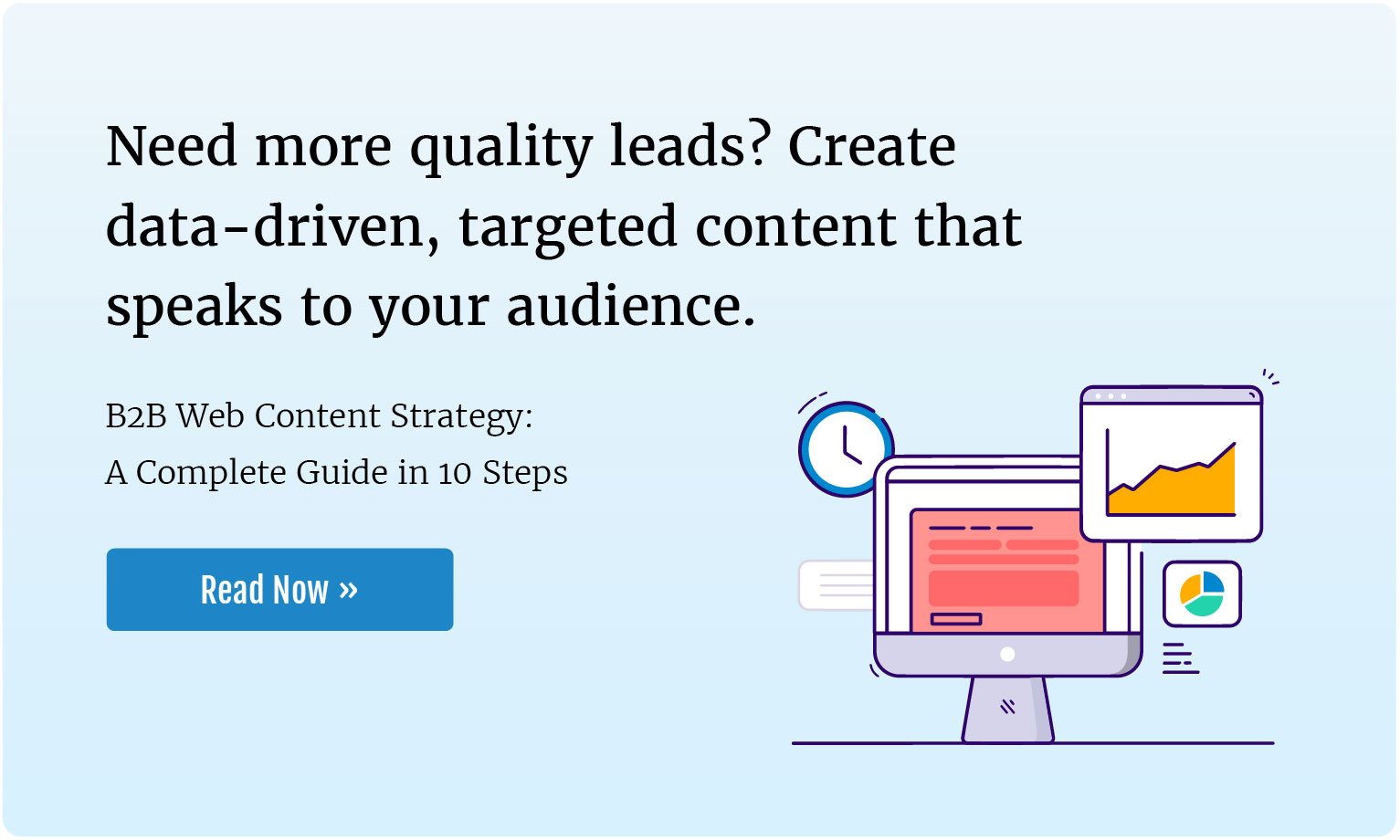Quality content is the backbone in any inbound digital marketing strategy.
But "content" has come to refer to so much, that it pretty much just means "stuff." Stuff you put on your webpages, stuff that makes up blog posts, and stuff you post on social media.
It's a broad term that can apply to almost anything (website copy, downloadable whitepapers, ad copy, etc.), yet each type of content has its own unique set of features and best practices that necessitate its own creative process.
While creating a full content library covering various topics is still important to generate search traffic, today we're going to focus on creating a gated piece of content, sometimes referred to as premium content or a lead magnet.
There are many different types of premium content, from whitepapers, guides, and case studies to webinars, tools, and checklists.
Regardless of the form it takes, premium content offers valuable information worth paying for. Instead of paying for it with money, however, the reader exchanges their contact information to acquire it.
In return, they receive a nugget of free consulting—something that can help them save money or make more of it.
These days, many people understand that personal contact information can be a form of currency and willingly give it up if the offer is compelling enough and fits their needs.
The trick is creating something that your ideal customers find valuable enough to pay for with contact information.
Here, we’ll dive into putting such a content piece together, step by step.
TABLE OF CONTENTS
Before you start writing
Before you dive into content creation, you need to make sure:
- Your website can support premium content
- You understand your audience
- You’ve done enough research
- You know what your competitors have already said about your chosen topic
Step 1: Make sure that your website supports gated content
This step is simple, yet critical. Does your website have the capabilities to create gated content (content which resides behind a form)?
You will need to be able to:- Create landing pages for readers to arrive on that are designed for collecting information
- Embed forms that can act as gates that collect information from readers
- Be able to send an automated email that will deliver the content that readers purchased
If you don’t have capability in any of these areas, start there before going further. Talk to us for help if you’re not sure where to start.
Step 2: Understand your personas
Anytime you write anything with a goal in mind—such as generating leads—it’s important that you understand your audience inside and out first.
This is particularly true for premium content, because your aim is to create something so compelling that readers will give up personal information to get it.
If you’ve worked in your industry for a while, odds are you already know your audience, including their problems, habits, and goals.
However, if you’re not sure who you are writing for, or need a tool to organize your thoughts, identify the buyer persona you would like to target with premium content before you choose the topic.
A buyer persona is a fictional representation of your ideal customer. Many businesses have more than one. For example, a law firm that practices both criminal law and family law may have different personas for each specialty.
.jpg?width=600&name=5ef222587abc7188188a7d0e_Make%20My%20Persona%20(1).jpg) A buyer persona for a criminal law firm; Source: HubSpot
A buyer persona for a criminal law firm; Source: HubSpot
To create a buyer persona, think about traits that your best customers have in common. Most of the people who land on your website have come there because they have certain problems, needs, and/or questions.
The leads who convert into customers have problems that you can solve with your products or services. Think about what problems your products solve, and who tends to have those problems.
What sort of questions do they ask before making a purchase? What factors make or break their buying decision?
Come up with a profile with just the information you would actively use. Think of it as a cheat sheet rather than a biography. HubSpot has a nice tool to help you do this quickly.
It’s also important to identify your persona’s stage in the buyer’s journey.
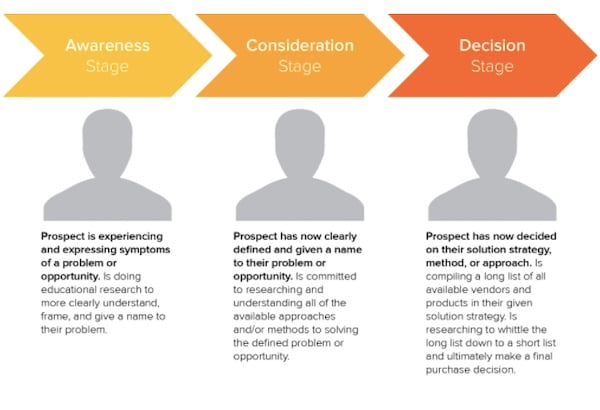 Source: HubSpot
Source: HubSpot
The buyer’s journey breaks down the different stages a buyer goes through before making a purchase, including the type of information they seek at each stage.
This is similar to the sales funnel model, except that it’s more from the buyer’s perspective, rather than the company’s point-of-view. There are three major phases:
- Awareness: The prospect is experiencing symptoms of a problem, but they don’t know what that problem is. Their goal at this stage is to identify the problem.
- Consideration: The prospect has identified their problem, but they don’t know the solution. Their goal is to understand what possible solutions exist.
- Decision: The prospect has identified their problem and chosen a solution, but they haven’t decided on a vendor. Their goal is to pick a vendor.
When choosing a persona to target, decide whether the premium content you want to write will be for awareness, consideration, or decision-stage buyers. Ideally, you should create content for all three.
Each category of content performs a slightly different function, but together they move the prospect further down the funnel toward a purchase.
- Awareness stage content helps prospective buyers identify their problem. For example, if you sell editorial services, you might create an infographic about common grammar mistakes and how to correct them.
This type of content is great for getting you on a prospect’s radar and beginning to establish your authority on the topic. - Consideration stage content helps prospective buyers explore solutions to their problem. For example, if you provide real estate services, you might create a checklist for how to prepare your house to go on the market.
This content is great for building a relationship with your prospect so they begin to rely on your expertise. - Decision stage content helps prospective buyers decide which vendor to choose. For example, you could create a case study that presents hard data about how your business has successfully helped a client.
This content is great for prospects who are ready to buy but need reassurance they are choosing the right vendor.
Step 3: Do your market research
Next, find out what your personas most want to know and what forms of content they most like to consume. Figure out where your persona likes to spend time online and what forms of content they already enjoy.
You can go about this several ways:
- Examine FAQ questions to identify gaps in understanding. This may be based off of questions clients ask you regularly, or from examining common Google searches.
- Use keyword research tools like Google Keyword Planner, SEMRush, or Ahrefs to validate brainstormed ideas against search data.
- Ask customers directly. A survey is a great way to do this, especially if you have an email or newsletter list. For webinars, it might make sense to tell your customers that you will be hosting one, and ask them what they want to learn about.
- Examine your major sources of leads. This can give you an idea where your persona spends time.
- Hire a market research firm to find out for you.
- Read articles and studies about buyer behavior within your industry.
Your goal at this stage is to learn what information your persona needs and is actively searching for rather than trying to guess. Then, you can create a product (a piece of premium content) that satisfies this demand.
This benefits your business because you can generate qualified leads easily as visitors come to your site with common challenges and needs. Your premium content should provide them with information they need to help make a decision.
The secondary benefit to your business happens when your lead is more educated and an easier sell because they've already established trust with your brand through interacting with your premium content.
By being there as an expert, you’ve demonstrated your capability to help them without even talking to them.
Step 4: Examine your competition
Once you’ve identified a topic that interests your persona, do some research to determine what’s already been said about it and how you can say it better or differently.
Start by doing some Google searches around the keyword phrases you’re looking to target. Read other content on your topic to learn what kind of content Google sees as relevant to the query and uncover opportunities to create something better.
As you’re reading other content, ask yourself these questions:
What do they do well?
For example, maybe you look at a competitor’s white paper, and they’re doing almost everything right. They cover the topic thoroughly, employ nice design, and use images, for example.
You might notice they use links to resources their readers can use to gain a deeper understanding. In that case, you will want to include helpful links in your content.
What do they do poorly?
Let’s say result number five is a guide with helpful information but terrible design. This is great, because you can create a white paper with both helpful information and sleek, professional design.
What subtopics do they cover?
Identify which subtopics they cover and what sorts of information they include. Say your competitor's post about ROI includes an equation for calculating a customer’s average purchase value. You might want to include an equation like that, too.
What don’t they cover?
Next, identify what your competitors leave out of their content. What subtopics do they fail to discuss? For example, say your competitor is writing about local SEO, but they don’t talk about the value of reviews. Cover reviews in your local SEO guide.
Are there subtopics that could be covered in greater detail?
Look for subtopics your competitors address but don’t cover in detail. Also look for opportunities to add more value by including things like actionable steps that help your readers carry out your recommendations and links to resources.
Are there opportunities to simplify or clarify a concept?
Is a concept explained poorly or in a confusing way? Explain it clearly and concisely.
Are there opportunities to illustrate a concept visually?
Are there concepts that would benefit from a photo, screenshot, illustration, video, or graph?
For example, if you wanted to explain the concept of the sales funnel without visual aids, a reader might get lost. However, if you include a graphic, it suddenly becomes easier to follow.
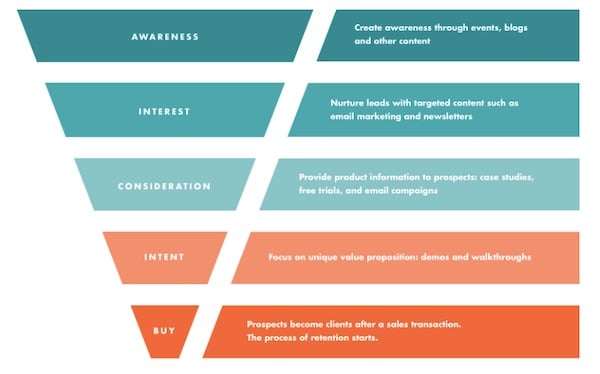 Source: Moz
Source: Moz
Some topics have been discussed to death. If you choose to write about one of these, consider what hasn’t been said already, or what perspective hasn’t been taken.
This method of auditing your search page competition to make better content is called the skyscraper technique, now updated to skyscraper technique 2.0, which can help you improve upon your competition to appear higher in search results.
When you sit down to write
Be Original
It’s important to research what has already been said and glean what competitors are doing well or poorly, as we discussed previously. However, sometimes writers take it too far.
Content curation, or repurposing bits and pieces of other business’s web content for your own, has been a common practice in the content creation world.
Another practice, content scraping, amounts to stealing and republishing content from other websites.
Content curation can be permissible if adequately cited or used as a starting point from which to expand on the topic and add original ideas, but is not ideal. Content scraping is a definite no-no.
Both practices are unoriginal, and not as useful to the reader or as enticing to Google as something fresh and new.
Sometimes scrolling through Google result pages is like playing telephone. You read an article written by one business and then visit another page that repeats the same information in a slightly different way.
Writers short on time or money may resort to these methods.
One way to get a new angle on a topic is to source your information directly from a subject matter expert. Set up an interview with someone in your company, a client of yours, or other business associate who knows a lot about your chosen topic.
If you don’t know anyone personally, search websites like Upwork or Freelancer to find an expert.
Talking to an expert can provide you with a lot of information in a hurry, but also help you challenge assumptions you might have about the topic, provide a different perspective, and help you identify subtopics you weren’t aware existed.
If you’ve never interviewed someone before, here are some tips:
- Research the topic and the expert you will be speaking with. This will help you ask better questions and identify what you need to learn.
- Prepare questions before the interview. Clear, open ended-questions can be particularly helpful, since it may encourage the interviewee to offer longer answers.
- Send the interviewee the questions before the interview so they can prepare.
- Schedule enough time to get the information you need. This will vary depending on the length and depth of the content you want to create.
Generally, it’s better to give yourself an extra few minutes than run out of time without getting the answers you need. - Break the ice. Be sure to ask the interviewee how they are doing and introduce yourself if you haven’t met before. For a good interview, it’s important to establish trust and make sure that you and your interviewee feel as relaxed as possible.
- Tell the interviewee what you want to achieve with the information they give you and what you will ask of them. This helps them understand what you need and establish trust by acting above the board.
- Record the interview with their permission. This is easy if you are working with video conferencing software like Zoom. You can also use a recording app on your computer or phone if you are conducting it in person.
- Ask follow-up questions when you don’t understand the expert, or when they mention something that interests you. For example, if your interviewee uses a term you don’t understand, ask for an explanation.
If they casually mention an interesting experience or subtopic, encourage them to go into greater depth. Don’t be afraid to go off-script. - Let them do most of the talking. Ask questions as needed to get them started, and let them talk.
- Ask if you can contact them again with more follow-up questions, as needed. As you begin to write, more likely than not you will discover gaps in your knowledge, or realize that you did not fully understand the interviewee on certain points.
Select the best format
Select the form of premium content that suits your audience and conveys your ideas the best.
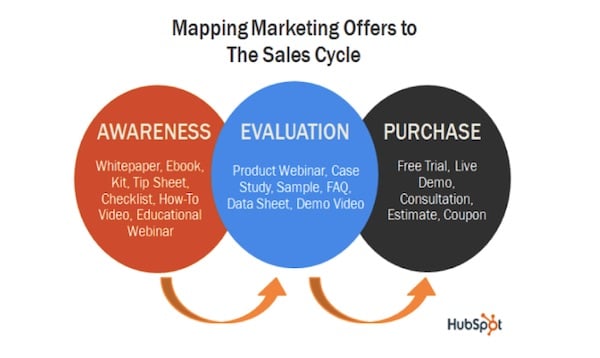 Source: HubSpot
Source: HubSpot
Ask yourself:
- What sorts of content does your audience like to consume?
- How much time do they have?
- What they are trying to accomplish by reading, watching, or using your content?
As we discussed earlier, awareness-stage buyers read content in order to identify their problem. Consideration-stage buyers read content in order to find solutions, while decision-stage buyers read content to identify the best vendor.
Keep in mind that you can always repurpose your offer and nurture your leads while you're at it. As an example, if you create a short checklist, you could then create a follow-up offer using an in-depth video walk-through of each checklist item.
So what are your options? You’ve probably seen the gambit of premium content on the web, but here are a few common types.
Webinars
Webinars are virtual seminars that take place over video conferencing software. The benefit of this format is that it’s interactive, which allows potential customers or employees to ask questions.
This may be particularly useful for consideration-stage buyers who are looking for solutions to their problem.
Time commitment: moderate
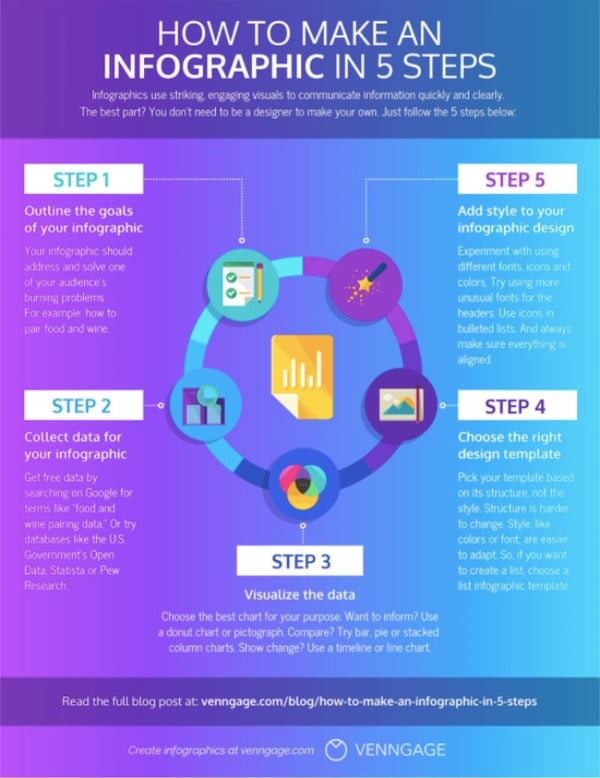 Source: Venngage
Source: Venngage
Infographics
Infographics convey information efficiently in a visual format. They’re great for reframing dry statistics in an engaging way, expressing complicated ideas clearly, and are easy to share. They’re useful for informing awareness-stage buyers.
Time commitment: low
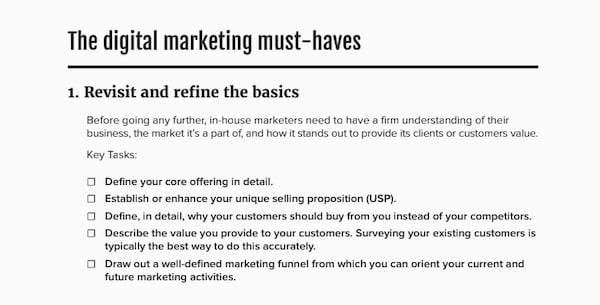 Source: Madison Marketing Group
Source: Madison Marketing Group
Checklists
These are just what they sound like: to-do lists for a particular action, such as creating a Google ad group. These are helpful, quick reads that consideration-stage buyers may find useful for problem-solving.
Time commitment: moderate
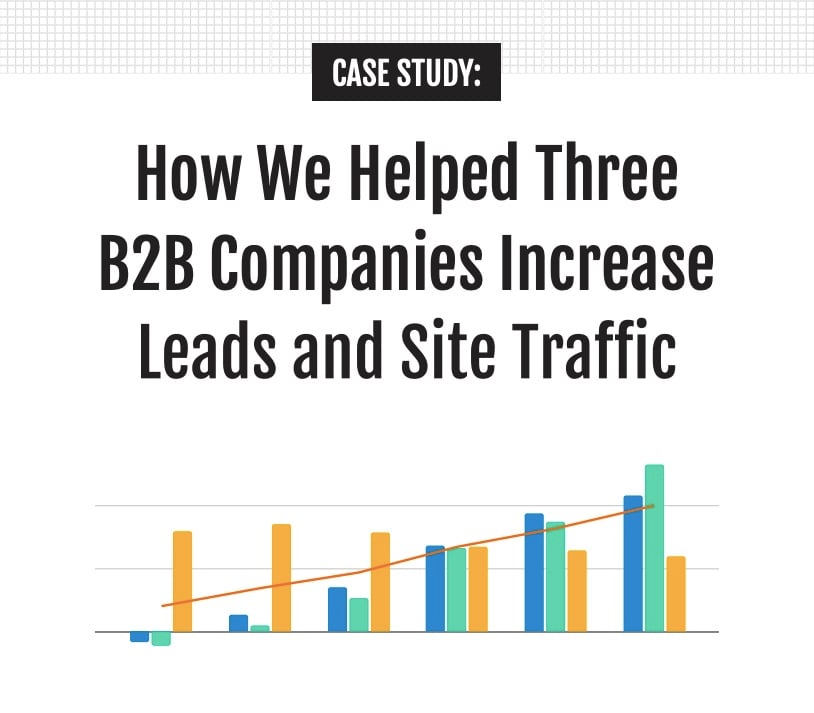
Source: Madison Marketing Group
Case Studies
Case studies are in-depth analyses of one unit. In marketing, this is typically a campaign or work for a particular client. They are a great way to demonstrate why decision-stage buyers should choose your business over other vendors.
Time commitment: moderate-high
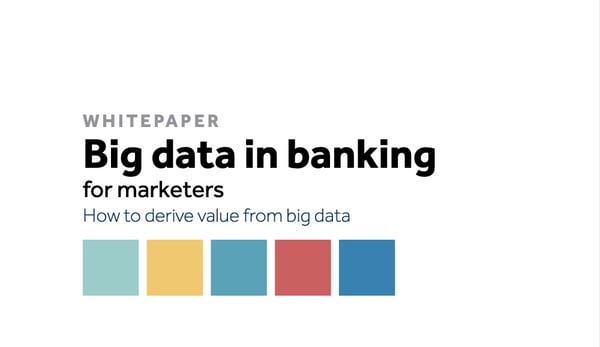 Source: Paperflite
Source: Paperflite
White papers
White papers are in-depth reports on a particular subject that present a problem and offer a solution. These reports can be great for helping consideration-stage buyers learn about solutions to their problem.
The terms “white paper” and “E-book” are sometimes used interchangeably. Some discern between the two, pointing out that E-books are formatted like a book. However, they are more or less the same.
Time commitment: moderate-high
 Source: Madison Marketing Group
Source: Madison Marketing Group
Guides
Guides are detailed overviews of a single topic, such as "search engine optimization." These are great for awareness-stage buyers who want to learn more about a particular topic and ground themselves with the basics.
They can also be helpful for consideration-stage buyers trying to find solutions, since guides generally contain background on the problems and offer solutions. They are similar to white papers, but more broadly focused.
Time commitment: high
Establish a tone
When determining the tone in which to write your piece (formal, educational, casual), again, consider your audience. Write in the same manner that you would if you were having a face-to-face conversation.
Depending on your ideal customer, your tone may be more formal, or it could be friendly.
Your tone should also be influenced by where the piece fits in the buyer's journey.
If it's a lead's first interaction with your company outside of finding you through a blog post, you'll want to ensure industry terms are explained while balancing the depth of information provided on a topic.
Create a clear, pleasing design
Appearance makes a big difference when it comes to content. While it might seem like written forms shouldn’t require more than a word processor to produce, a sleek, utilitarian design signals professionalism.
Plus, well-designed content tends to be easier to read and more engaging.
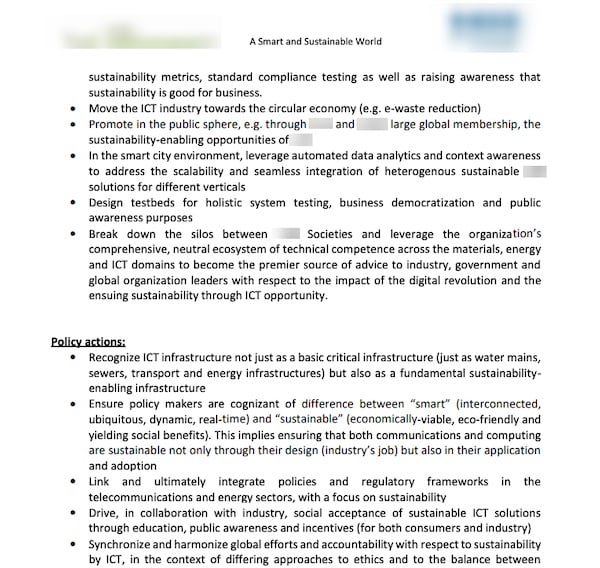 A scientific white paper with very little design
A scientific white paper with very little design
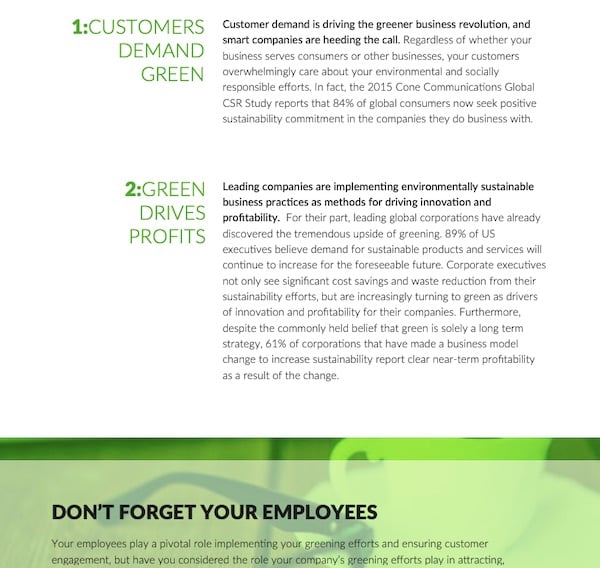 A marketing white paper with design; Source: Green Business Bureau
A marketing white paper with design; Source: Green Business Bureau
In other industries, it might make sense to keep design to a minimum. However, in content marketing, it may be the difference between a lead that reads your whole white paper, and one that gives up part way.
Premium content also offers more freedom in the use of visual elements like images, illustrations, and icons, because you're not limited to your existing blog or website template.
Here are a things to keep in mind when designing content:
- Is your design (either overall or an individual element) in line with your company's brand standards? In order to keep your company’s brand identity consistent, everything you create should line up with your brand guide.
- What does each design element do to help further the lead’s understanding? Charts and graphs quickly display information, but a decorative picture does nothing to further the lead's understanding of the topic.
- Does your design feel cluttered? One of the fundamental values of UX Design (user-friendly web design) is “less is more.” Streamline your design to include only the most important, useful elements.
- Are you using headlines and subheadlines? Pages use headlines and subheadlines to break up and organize text. This helps readers quickly understand how different ideas relate and when you transition to a different topic.
- Have you chosen two fonts that you use consistently? Choose one font for text, and one for headlines and subheadlines. If you have a company brand guide, you may already have designated fonts.
- Have you chosen three colors that you use consistently? Choose two or three colors (one major color, and an accent color or two). If you already have company colors, use them.
If you have a designer in-house, ask them to design premium content for you. Failing that, it may be worth it to hire a freelancer. The longer the content, the more quality design might help hold your reader’s attention.
Optimize your landing page for search engines and leads
The landing page is the gate that your visitors must enter through to access your premium content. A standard landing page includes information about the offer along with a form for your lead to pass their information to you.
When you're creating your landing page, there are some best practices you will want to follow to maximize its lead generating potential:
- Write clear, concise copy describing your offer and what people can expect. This helps visitors choose whether to move forward. By including keywords on your landing page, search engines are able to find and offer it in related search results.
- Design for decision-making. One key to landing pages is to make sure your visitor understands the next step. Removing your standard website navigation reduces the chance that a visitor will wander away from the page.
Shorter copy that gets right to the point and plenty of white space helps a visitor focus and quickly make a decision. Finally, a clear and simple form makes it easy to access the premium content. - Keep your form in line with your offer. If your premium content fits earlier in the buyer's journey, stick with a few easy questions on your form. If the offer fits a later stage in the buyer's journey, it's OK to ask for additional information.
- Link to your landing page from relevant blog posts and website pages. Make sure your premium content is a logical next step for someone who has read a particular page on your site.
Clicking on a call to action (CTA) so they can learn more about a topic of interest is a natural flow and proven way to nurture leads.
If you’re interested in more landing page tips, check out “5 Quick Landing Page Fixes to Increase Franchise Website Conversions.”
End with a Call to Action
Another great place to put a CTA is within your premium content. Following the same example of a blog post leading into your premium content offer, you want your premium content offer to lead into something that will continue to nurture your lead.
Depending on your business and the stage of your buyer, this could be a webinar that helps them solve their problems or a case study showcasing an example of how you helped a real customer.
Remember, premium content is just one part of an effective inbound marketing program. Integrate your efforts here with your call to action, email template, landing page, and lead nurturing copy creation.
Edit
We’ve all seen it: an otherwise well-written piece of content with one or two distracting typos. A single typo can make your carefully-crafted content look carelessly written, even after hours of work.
That’s why it’s best to pay a good copy editor to read through your content before you publish it. Ask a qualified person from your team or hire a freelancer to ensure that your content looks clean and professional.
Premium content don’ts
Don’t steal free content and curate it into a gated piece
Some writers will curate bits and pieces of content from other web pages and stitch them together into a new piece of content. Many resources online are free, including information from authoritative sources like organizations or government agencies.
Don’t re-package content that readers can find for free and present it as a new piece of gated content. This doesn't offer new value and would reflect poorly on your business if they found the same content elsewhere for nothing.
Instead, create new content that makes readers feel satisfied in their purchase.
Don’t overpromise
Don’t make promises you can’t keep. It’s a bad idea to mislead readers into thinking that your content is more useful than it is.
For example, if you promise readers a definitive guide to setting up a filing system but do not provide actionable steps, then readers may feel cheated.
Instead, be honest about the value and purpose of your content, and try to create the best resources possible.
Don’t turn it into a brochure
Have you ever downloaded a business’s premium content or visited a web page that’s little more than an ad for their services?
This sort of content is not helpful to a reader and may turn them off your business, especially if they gave up their information to download it.
In your premium content, focus on showcasing expertise and moving your reader further down the sales funnel (or buyer’s journey). Directly promote your business on the pages of your website that are designed to showcase your products and services.
Conclusion
Hopefully these best practices will help you get off to a running start in writing stylish, informative premium content for your business.
Topics: Premium Content
Chris Murvine, CEO
Chris Murvine has worked in the digital marketing industry for over 20 years, developing expertise in technical-marketing strategies and growth-platform implementations. He founded Madison Marketing in 2008. Outside of the office, he enjoys spending time with family, camping, and riding all-terrain vehicles.


